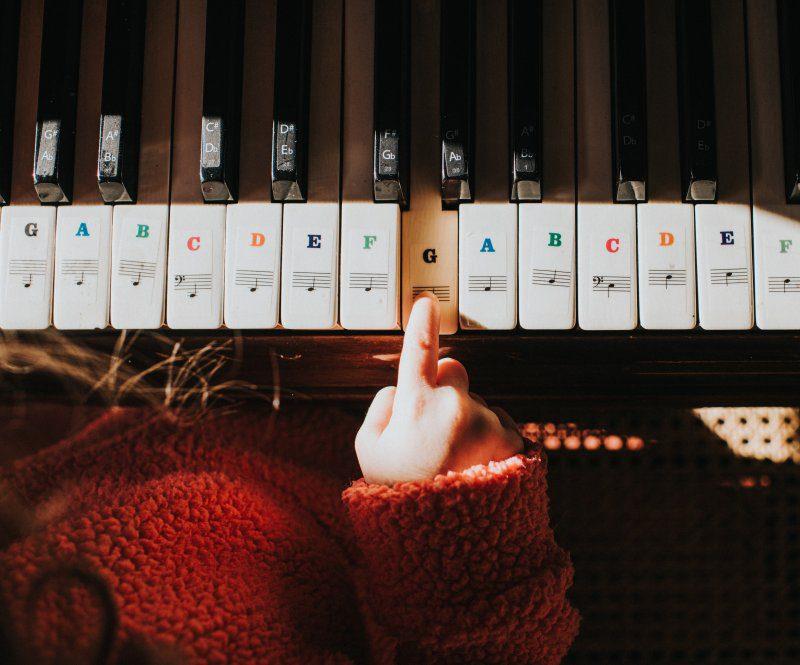Welcome to part two in this series “Music Theory for Singers.” In this article we’ll cover how to read pitches. In part one of this series we learned how to read rhythms. Rhythm is how long or short you sustain a note. Pitches are how high or low the note you are singing will sound.
In music there are 7 natural notes (pitch names) and 5 accidental notes (pitch names). The musical alphabet goes from A to G, and then just repeats after G, back to A. It looks like this.
A B C D E F G A B C D E F G and so on in both directions.
To help with understanding the concepts today I will provide a diagrams As singers we don’t play any buttons or valves, so having visual representation is very helpful in theory retention. Below is a diagram of the note (pitch) names on a keyboard.
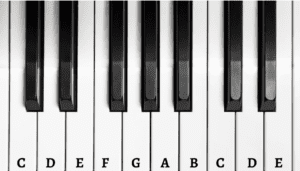
No matter where you start in the musical alphabet, it just repeats. In the diagram above we started on the letter C. This is a very common note to start on. Most keyboards and pianos start on a C pitch, and C is the most simple key signature for understanding theory. There are 2 “C” pitches in the figure above. The one on the left is lower than the one on the right.
**Although the English alphabet starts on A, the musical alphabet usually starts on C when being referenced.
In your voice instrument the first C pitch on the diagram would resonate more toward your jaw or clavicle (chest voice). The second C pitch would resonate closer to your nose or eyebrows (head voice). Although the 2 C notes share a name they are different in how they sound because they both create a different frequency.
Frequency of Pitches: The first C pitch we encounter on the above diagram is C4. Known as middle C. The frequency of middle C is 261.63hz The second C we encounter is known as C5. It resonates at a frequency of 523.25Hz. Exactly double of C4.
The C below C4, known as C3, resonates at half the hz of middle C. Each of the pitches in between follow the same pattern. Every D doubles in frequency as it gets higher. Every F pitch resonates at half the frequency of the previous one as the notes descend, or get lower.
Accidentals: In between the natural notes live accidental pitches. All accidentals have 2 names. How you refer to an accidental at any given time depends on the key signature you are in. We will cover key signatures in part three of this series “Music Theory for Singers.”
To the right of any given natural note is the sharp version of that note. It is 1/2 step higher than the pitch it is named after. To help understand the way an ascending 1/2 step sounds, hum the first 2 notes of “Jaws.” Yes that’s right, the movie about the shark.
To the left of any given natural note is the flat version of that note. It is 1/2 step lower than the pitch it is named after. To help understand the way a descending 1/2 step sounds hum the first 2 notes of “Joy to the World.”
Below you will find a diagram of the 5 accidental notes on the keyboard. The accidentals are on the black keys. Sharp is written as # and flat is written as b. F# is pronounced F sharp. Ab is pronounced A flat. There are no accidental notes in between B and C. There are also no accidental notes between E and F. Can you identify this pattern on the keyboard?
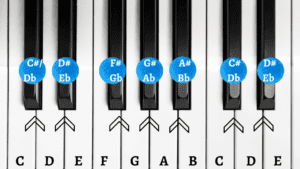
Pitches on a staff: Now that we have covered the order that notes appear and how two notes can share the same name, but not the sound the same, it’s time to talk about writing notes on a staff. When pitches appear on a staff they are written/read left to right. The higher the note is on the staff the higher the note is pitched. The lower the note is written on the staff the lower the note is pitched.
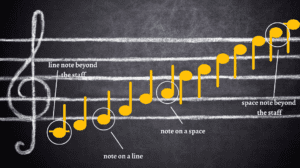
The pitched notes continue up and down the staff existing on a line or a space. The staff is comprised of 5 lines and 4 spaces. Once notes are written higher or lower than the staff they continue on with added lines and spaces. The lines are numbered from line one on the bottom and line five on the top. The spaces also start from the bottom with space one and continue to space four on top.
The five notes that exist on the staff lines are E, G, B, D, F. An acronym to help you remember these notes is “Every Good Boy Does Fine.” The four notes that exist on the spaces of the staff are F, A, C, E. The notes spell out the words Face.
The notes beyond the staff continue with the musical alphabet in ascending or descending order. Take a look at the labeled notes on and off the staff diagrams below, familiarize yourself with their pattern, and re-read anything you need refreshing on, before we move to the next part.
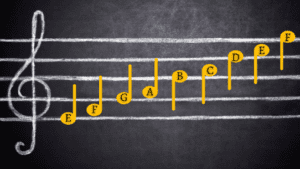
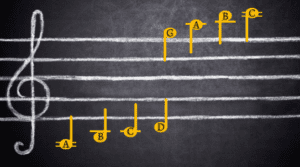
The C just below the staff on the first additional line is middle C, also known as C4. The C on the third space within the staff is known as C5, or the c above middle C. The c written 2 lines above the staff the highest c on the second diagram is known as C6. C6 is the first pitch of the elusive whistle register.
Adding rhythm to pitch: Now that you have worked on identifying rhythms and pitches it’s time to take your music reading to the next step. It’s time to combine notes and rhythms in the context of each note you read.

In the diagram above you can see a time signature of 4/4, meaning there are 4 beats in every measure and the beat we are talking about is a quarter note. There are four measures of music. The first note is E. The pitch of this E note is E4, sung slightly above middle C. The first measure has 2 quarter notes and 1 half note. All 3 notes in the first measure are on the same line meaning they all sound exactly the same. The only difference is the amount of time each note takes up. Can you read this music and take a guess on what popular song this might be?
If you guessed Jingle Bells you’d be correct. Even before you are fluent in reading music you will be able to identify simple patterns. You can tell when a note is higher or lower. You can tell if the notes are all close together, or if there are leaps between the notes.
With rhythm you can tell how long to hold each note. With pitches you can tell how the melody goes. With rhythm and pitches you’re singing songs.

In this next diagram (above) we are again in 4/4 time. Because 4/4 is the most common time signature it can also be symbolized by a letter C, meaning common time. How many measures do you see? How many half notes are there? How many eighth notes? Are you able to tell what famous song this is? Are the pitches close together like the “Jaws” theme song, or are there big jumps between the notes like the opening notes to “Somewhere over the Rainbow?” Can you label the notes by pitch names?
**Answers: There are 8 measures, 2 half notes, 2 eighth notes, the song is Ode to Joy, the notes are all very close together in frequency. There are no big interval jumps.
Pitch names: EEFG GFED CCDE EDD EEFG GFED CCDE EDD
In the above diagram, if you happened to notice the notes with dots after them, they are another notation for rhythm that we have not covered yet. If you are interested in diving deeper into your music theory studies, or have questions from any of the material we’ve covered, join me in a Takelessons Live class. This link will provide you with 30-days of free TL Live membership access https://bit.ly/3sFXGRQ . You’ll be able to ask questions, clarify the material, and put your skills to the test.
In the third part of this series we will cover the magical circle of fifths. I will simplify the circle in a way that will help you finally understand how and why you’ve heard so much about it, and what its purpose is. I look forward to sharing more music theory with you very soon! Happy learning.
Reina Mystique
